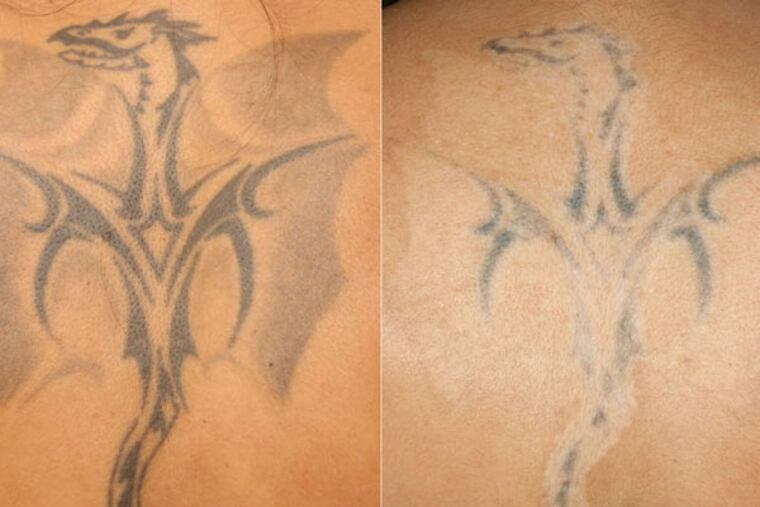Disappearing ink
The latest picosecond laser technology can remove a tattoo with fewer treatments, but it's still a pricey and painful process.

Rubber bands snapping really hard - painfully hard - against the skin. That's what laser treatment feels like to Marianne Morrison, who is getting three of her tattoos removed, including a large iris on the right side of her neck.
It hurts more than getting a tattoo done in the first place, said Morrison, 40, of Germantown. If only she'd listened to her husband, local tattoo artist Eric Eaton, who grudgingly did the ink she's trying to erase.
But the bartender wants to take the edge off her appearance and look more professional before starting nursing school.
"It's amazing, the difference, it's almost not even noticeable," said Morrison. Past treatments on her largest tattoo didn't work.
Morrison's dermatologist is using the newest advancement in tattoo removal, the picosecond laser. It beats dermatology's standard with greater speed - emitting light in trillionth-of-a-second pulses - and fewer treatments, according to doctors who use both.
It also costs hundreds or, more likely, thousands of dollars for multiple, intensely painful treatments (just like the old kind) - something to consider before you rush to undo your ex's name or that regretted skull and crossbones.
"I'm extremely excited about this new development," said Eric Bernstein, director of the Main Line Center for Laser Surgery in Ardmore. The older, Q-switched lasers operate more slowly, in nanosecond pulse durations. Even so, that's a billionth of a second.
Bernstein said he doesn't yet use the new laser in his regular practice but is intrigued enough to be researching its effectiveness. "More studies need to be done," he said. Research so far suggests the main benefit is that fewer treatments are needed.
Potential patients are not in short supply.
"There's a huge surge in tattooing, and there's a huge surge in people that want their tattoo removed," said Bernstein. Thirty-eight percent of 18- to 29-year-olds have at least one tattoo, according to a 2010 report by the Pew Research Center.
Only one picosecond laser is on the market: PicoSure, made by Massachusetts-based Cynosure Inc. and approved by the Food and Drug Administration in 2012.
It bursts tattoo ink into tiny fragments that are further degraded by subsequent treatments. The old technology works the same way, but leaves behind cobblestones compared with the sandlike results of the picosecond laser, said Franziska Ringpfeil of Ringpfeil Advanced Dermatology in Haverford.
Patients undergo four to eight treatments for single-color tattoos and six to 10 for multicolored ones, she said.
But it's not cheap. Dermatologists hoping to join the picosecond party pay nearly $300,000 for the device, leading to high costs for patients. Depending on the size of the tattoo, each treatment can cost from $250 to $3,000, a rate similar to the old technology, said Ringpfeil, who treated Morrison as well as Bill Knowles, 29, of Philadelphia.
Knowles has undergone five of an expected six or seven treatments so far, paying $670 each to remove a "hideous and ugly" multicolored tattoo on his right shoulder designed by his ex-girlfriend.
Patty Monaghan, 36, of Deptford, preferred childbirth to the pain.
"As soon as you're done, it feels like a really excruciatingly bad sunburn," said Monaghan, who has had four out of a likely five or six treatments to remove a dragon tattoo on her back that that is six inches high and five inches wide. "I would describe it as extreme pain."
Ringpfeil offers a cool stream of air aimed at the site during treatment and soothing cold packs afterward. Treatments can last from minutes to more than an hour depending on the tattoo's size.
Then the skin swells and blisters, as with a burn. It takes six to eight weeks to heal from each treatment.
"You have to be really careful about moving around and brushing into things," said Morrison, who is almost finished with the treatments to remove the three tattoos - a heart on her ring finger and a half-dollar-size star on her neck, in addition to the giant iris.
That part isn't much different from the nanosecond lasers. But you can get the same effect "in a much shorter time frame," said Nazanin Saedi, director of the Jefferson University Laser Surgery and Cosmetic Dermatology Center. She said that just two clinics in the region offer it - Ringpfeil's on the Main Line and Delaware Valley Plastic Surgery in Cherry Hill.
Ringpfeil, whose clinic has treated about 50 tattoo patients with the picosecond laser in the last year, said she hasn't observed any long-term side effects.
She has also used the laser to treat birthmarks, such as Nevus of Ota, a bluish-gray discoloration on the face.
Despite the price and the pain, Morrison said she would recommend picosecond laser treatment to a friend.
"I don't want to be a grandmother with tattoos on my neck," she said. "I have different priorities now."
215-854-2587